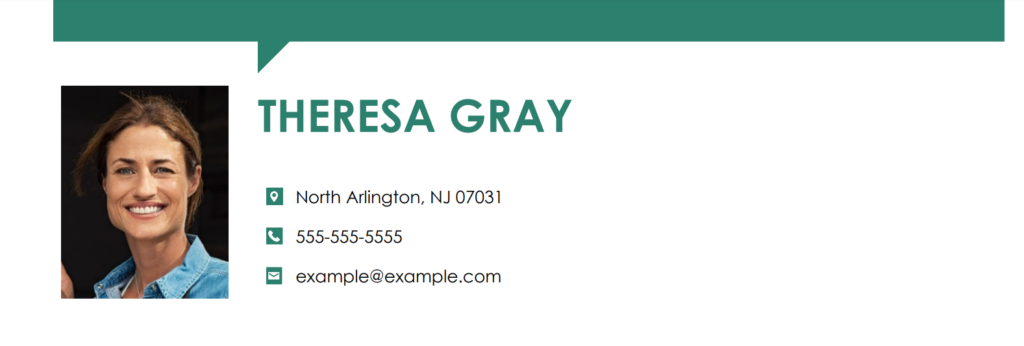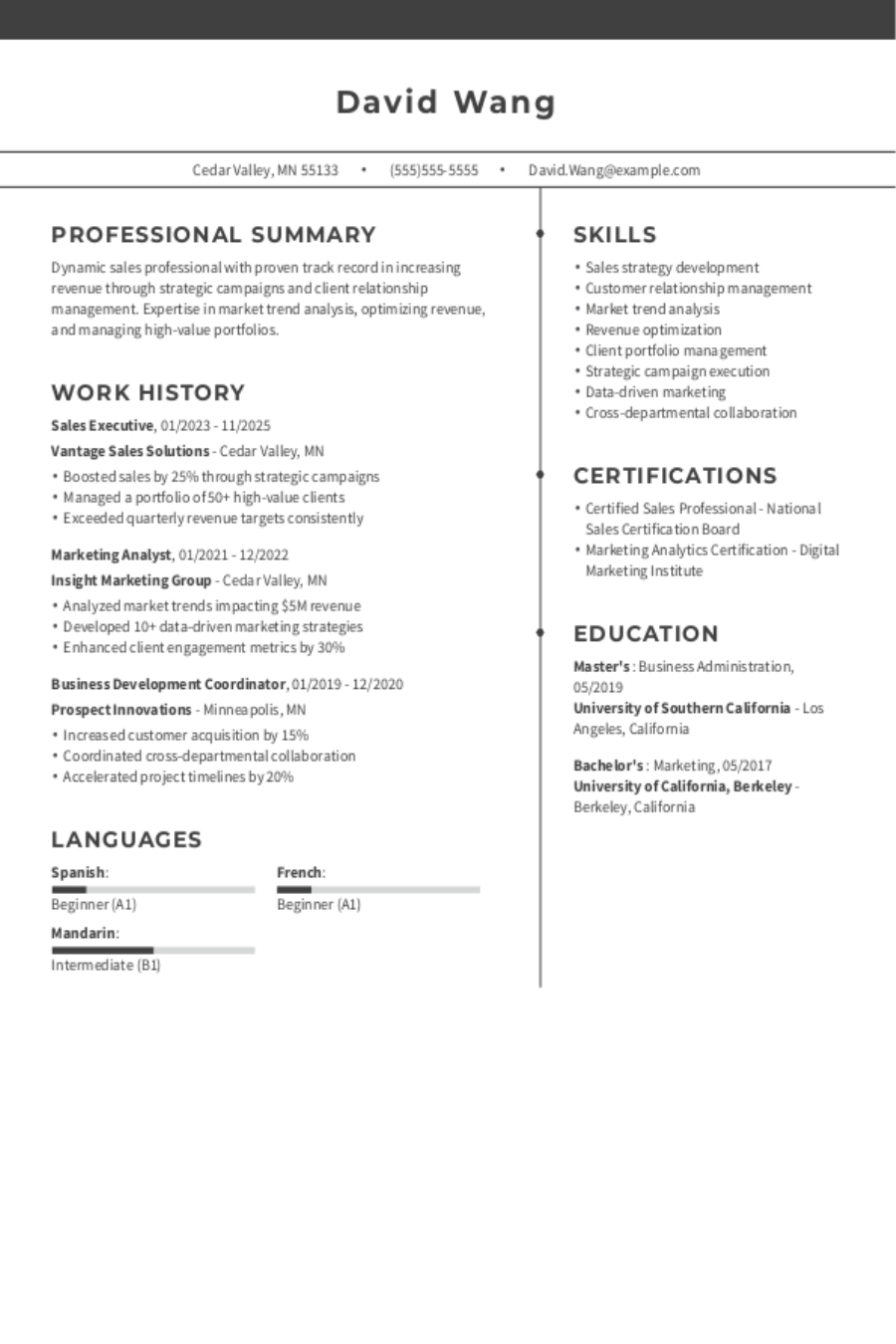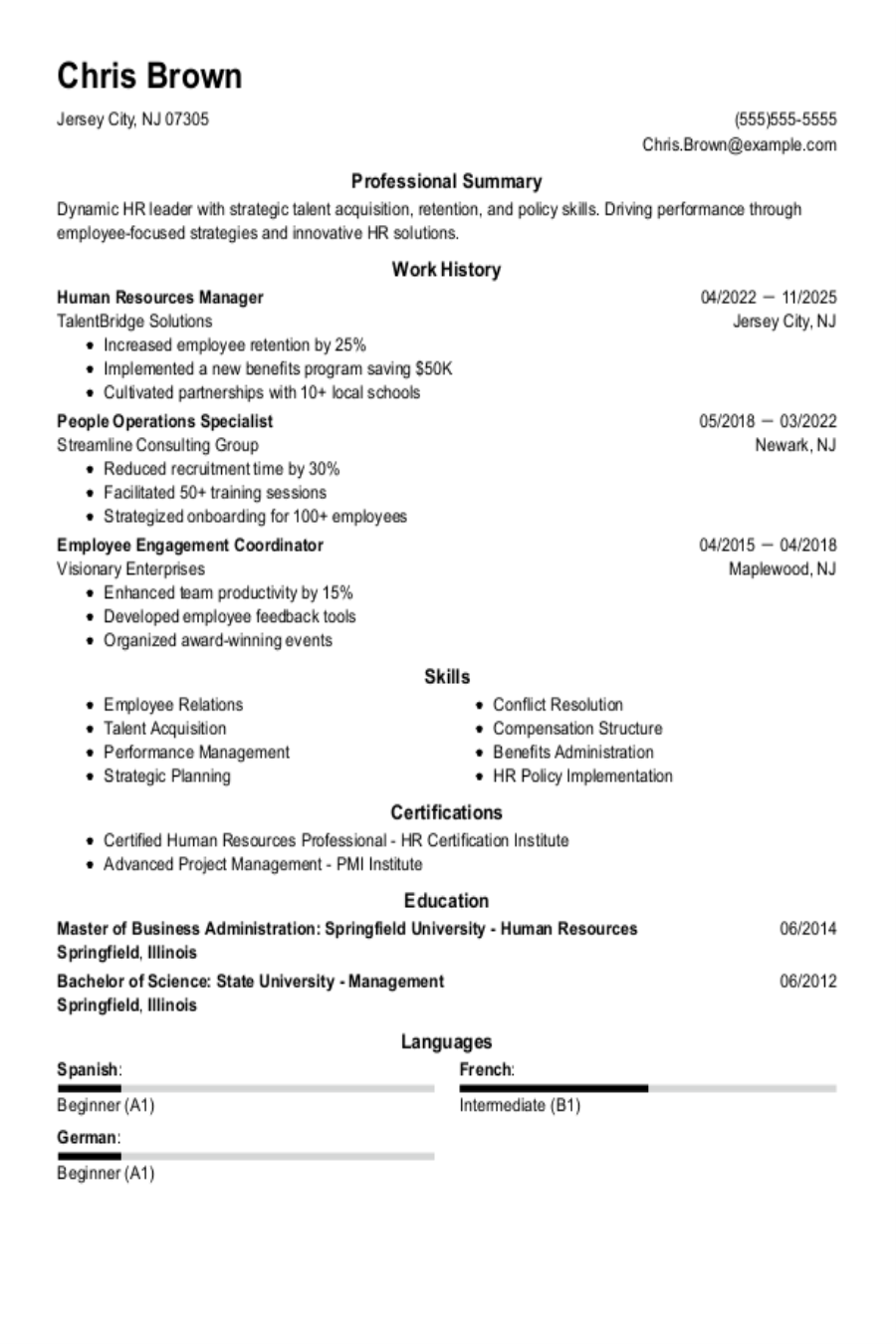Resume outlines are the easiest way to fill out a resume. Starting your resume with a structure and a plan eliminates some of the guesswork and helps you create a focused resume that shows employers what you can do.
But what makes a great resume outline? Our guide, complete with resume outline templates that you can use, will help you understand the structure of a great resume and organize your outline for success.
This guide includes:
- A text resume outline you can copy
- Resume outline examples at different career stages
- The six parts of a resume outline
- Additional sections to consider
Want to skip the outline and start building? Try our AI Resume Builder, which offers a selection of resume templates in a variety of styles. The builder will guide you through each section step by step, so you don’t have to worry about creating an outline.
Resume Outline Example
example@example.com | 555-555-5555 | Medford, MA 02155
Responsible and friendly sales associate adept at making customers feel welcome, listening to their needs, and promoting merchandise with practiced care and attention to individual needs. Proficient in merchandising, payment processing, and general housekeeping of store and storage areas. Focused, hardworking, and punctual with excellent interpersonal and organizational skills. Ambitious student pursuing a finance degree, eager to contribute developed knowledge in sales and business roles.
- Able to connect with customers with a positive attitude in a fast-paced environment.
- Skilled in performing cash wrap and mobile point-of-sale (POS) duties in an efficient and timely manner.
- Excellent mathematical skills; great physical condition.
Merchandising Knowledge
- Maintained knowledge of current promotions, exchange guidelines, payment policies, and security practices.
- Answered 20+ incoming telephone calls to provide information about products, services, store hours, policies, and promotions each day.
- Kept apprised of emerging trends and provided informative customer service to assist in product selection.
Financial Records Analysis
- Prepared cash deposits of up to $1,000 with zero discrepancies each week.
- Cashed out registers each day before leaving.
- Reviewed and resolved differences between accounting information and cash drawer.
Customer and Service Advocate
- Assisted customers by finding needed store items and checking inventory for items at other locations.
- Helped an average of 50 customers per day by responding to inquiries and locating products.
- Recommended merchandise to customers based on needs and preferences.
Sales Associate | 06/2023 to Current
Bed, Bath & Beyond | Medford, MA
Summer Sales Associate | 05/2021 to 06/2021
Marshalls & HomeGoods | Medford, MA
Bachelor of Science | Finance
Tufts University, Medford, MA | 06/2027
5 Resume Outline Examples for Different Job Seekers
Let’s review a handful of resume outlines. Each of these resume outline templates is designed to suit professionals at different career levels.
You’ll see that the resume outline examples below use different resume formats. Formats are simply ways to organize your resume sections. You’ll need to choose your format so you can do a proper outline.
Here are the four career stages we’re about to review:
- Entry-level
- Midcareer
- Senior-level
- Returning to work
- Career change
Let’s see how each stage uses a resume outline to their benefit.
Entry-level resume outline
In this functional resume format, the outline emphasizes the job seeker’s skills and abilities. With limited work experience, it makes sense for this candidate’s resume outline to focus on skills instead.
Midcareer resume outline
In this combination resume format, the outline balances skill sections with a work experience section. Midcareer candidates benefit from a balanced approach that showcases both work history and skills.
Senior-level resume outline
In this chronological resume format, the outline helps a more advanced job seeker show their work history, beginning with the most recent job and working backward. This format is perfect for people with a clear career trajectory.
Returning to work resume outline
Job seekers returning to the workforce have several options for a resume outline. In this case, the job seeker opted to balance their substantial work history with their skills so they could make the case that their career transition will be smooth.
Career change resume outline
In this resume outline, the skills are near the top, making it a great option for job seekers transitioning between industries. The outline effectively redirects the focus from industry-specific experiences to universal competencies and transferable skills, making your diverse background a strength rather than a challenge in any career shift.
How To Use a Basic Resume Outline
Starting your resume with a blank page means staring down limitless potential. This is a huge opportunity, but without a way to organize your thoughts, it can also be challenging.
Think of a resume outline as the foundation of your resume—it provides a structure you can then build upon as you make your resume. Using one will help you organize your thoughts and remember the critical information you need to write the best resume you can muster.
Now that you understand the purpose of an outline, let’s see what to include in yours.
6 Parts of the Best Resume Outlines
As you saw in the examples above, all resumes have five standard sections. Here’s a breakdown of what information belongs in each section to help you complete your outline:
1. Resume heading
Your contact information is a critical part of your resume. It’s not hard to come up with the content of this section, but ensuring that it’s properly placed, error-free, and accurate is critical.
The best spot for contact info is your resume’s header. Here’s an example of a well-made header:

Virtually every resume should include the following in the header:
- Your name
- Phone number
- Email address
Then, there are additional items worth your consideration:
- Location (city and state)
- LinkedIn profile
- Other social media profiles
- Job title
- Personal website
Pro tip: Ensure your resume design, including the header, is ATS-friendly. Use simple layouts and standard fonts, and avoid graphics or unusual formatting.
2. Professional summary or resume objective
The second part of your resume outline should be a resume profile.
Resume profiles come in two forms: a professional summary or a resume objective. If you have some work experience, a professional summary is best. Summaries include an overview of your most relevant experience and skills, and touch on your most impressive accomplishments.
Here’s an example of a good professional summary:
If you have little to no work experience, you should write a resume objective instead. An objective outlines your transferable skills, relevant education and training, and your career goals.
Here’s an example of a good objective statement:
Now, let’s move on to the third part of your outline—work experience.
3. Work or relevant experience
For most job seekers, the work experience section will take up the bulk of the page.
You’ll notice the work history sections in the best resume examples always do the following:
- Include the job titles, names, and locations of the companies the candidate worked for.
- List the positions in reverse-chronological order, starting with the most recent.
- Feature between three and five bullet points for each job entry. These highlight responsibilities and professional accomplishments.
- Use action words to give the resume a more dynamic, action-oriented feel.
- Insert as many keywords as possible from the job listing.
That last point is important. When you fill out the experience portion of your resume outline, make sure to read the job description closely. You should highlight the skills and abilities expected of you.
Those are keywords you should add to your resume. They’ll help you pass the automated screening process known as an applicant tracking system (ATS).
4. Skills and certifications
When you are creating your resume outline, study the job description closely so you can put together an excellent section for skills. In the job description, you’ll find the most important skills for the job.
Make a list of those skills you possess, then list other skills you have that would be helpful to the role, whether they are research skills or creative thinking skills. If you have completed professional training or certifications that are relevant to the role, you’ll want to add those here, too.
Your resume should include a mix of hard and soft skills. Together, they make for a well-rounded candidate.
Here are a few hard skills commonly found on resumes:
- Data analysis
- Research
- Foreign language proficiency
- Quality control
- Technical support
- Financial analysis
Here are a few soft skills commonly found on resumes:
- Collaboration
- Leadership
- Communication
- Work ethic
- Flexibility
- Creativity
Pro tip: Don’t forget computer skills! When you list your ability to use certain software programs, be specific by listing the exact name of the program.
Next, let’s talk about education.
5. Education
Your education section is the cherry on top of your resume outline. When listing your degrees, add the name and location of your institution and the name of the degree you received.
Only list high school in this section if it is the highest level of education you have completed. Also, don’t list your date of graduation unless you are a very recent graduate.
Pro tip: Your education section should generally go below work experience. But there’s one exception—if you are fresh out of college, you may want to place your education near the top for the first couple of years.
6. Optional sections
The core resume sections are just the start. There are a bunch of additional sections to consider for your resume outline that could take your candidacy to the next level.
While these are optional, they just might help you stand out from similarly qualified applicants. Sections include:
- Awards: Adding honors and awards is a great way to show potential employers that you bring your A-game to everything you do. In this section, add any academic, professional, or volunteer awards you have been given.
- Volunteer work: If you have done extensive volunteer work, especially if it is relevant to the role you’re applying for, be sure to list it on your resume. This is especially helpful for those job seekers with minimal professional work experience.
- Professional associations: Listing your professional associations is a great way to show recruiters and hiring managers that you are up to date with industry trends. Limit those you list to organizations that are related to the role you seek.
- Languages: If you are fluent in a second language, it could set you apart from the competition. Be sure to list it on your resume.
- Hobbies: Some job seekers choose to include this section to show that they are well-rounded individuals. While completely optional, this section could create interesting talking points in an interview. However, be careful not to include anything that could be off-putting to a potential employer, such as political or religious organizations.
Pro tip: To see how you can use volunteer work on your resume effectively, check out our teen resume example, featuring extensive volunteer work experience.
4 Resume Outlines to Fill in Easily
There are so many different types of resume outlines it can be hard to pick one. We’ve gathered four strikingly unique looks for you to review. Pick one, open it up in our builder, and fill in each section with expert guidance every step of the way.
Simple
Simple resumes are a great choice for most candidates because they keep the focus on your content and avoid unnecessary distractions. They’re great for any industry but especially no-nonsense professions like finance and accounting. The outlines are quick to fill in, too, and always ensure your qualifications are front and center.
Modern
Another option is modern resumes. They’re perfect for industries like technology and marketing where innovation is valued, but anyone can use them.
Creative
For some pizazz, choose an outline like a creative resume. Creative resumes are visually appealing, but they should only be used in appropriate settings. Candidates in creative fields like graphic design and fashion may benefit from the expressive style of a creative resume.
Headshot
In the U.S., very few people include photos on their resume and we’d mainly recommend them for actors and certain creative roles. In some other countries, you can use a headshot resume in virtually any industry.
Key Takeaways
Always outline your resume
You wouldn’t build a house before creating a blueprint, right? Outlining your resume will guide you through every step.
Outlining your resume will save time
Another benefit of resume outlines is you spend less time deciding what to write because the structure is already set.
Resume outlines have six core sections
There are six critical sections to any resume: header, summary, work experience, skills, education, and optional sections.
Resume builders outline your resume for you
If you want to skip the outlining process, consider using a builder tool. These tools typically walk you through your resume section by section—and they’re free to use.
FAQ About Resume Outlines
Last Updated: June 16, 2025
The best outline for a resume is one that clearly presents your qualifications in a clean and organized manner, making it easy for both hiring managers and applicant tracking systems (ATS) to read and understand.
To outline experience on a resume, list your work history in reverse-chronological order, starting with your most recent job. For each position, include the job title, company name, location, and dates of employment. Use bullet points to highlight key responsibilities, achievements, and quantifiable results.
Every resume outline should include the six parts of a resume, these are:
- The header
- Professional summary or objective statement
- Work experience
- Your skills
- Education, including a list of your degrees
- Additional sections, such as certifications, volunteer work, or professional affiliations (if applicable)
Was this information about 9 Professional Resume Outline Examples For 2025 helpful? Let us know!
Don is a Certified Professional Resume Writer (CPRW) with more than 10 years’ experience creating digital content, including four years helping job seekers develop their careers. He holds an M.S. in Journalism from Northwestern University.
More resources

The AI Boss Effect: 97% of Workers Have Asked ChatGPT for Advice Instead of Their Manager
Resume Now s latest report explores how AI is replacing manage...

37 Unique Skills to Put on Your Resume
Trying to avoid the skills you see pop up on resumes repeatedl...

Resume Now Spotlights 14 High-Innovation, High-Growth Jobs That Pay $60K+
Resume Now s latest report highlights some of the highest payi...

Sales Resume: Examples, Templates & Tips
Planning to pursue a sales career? Let our samples templates ...

IT Resume: Examples, Templates & Tips
Our resume examples templates and writing tips will help you ...

Human Resources Resume: Examples, Templates & Tips
Build & download your Human Resources resume in a few simple s...
